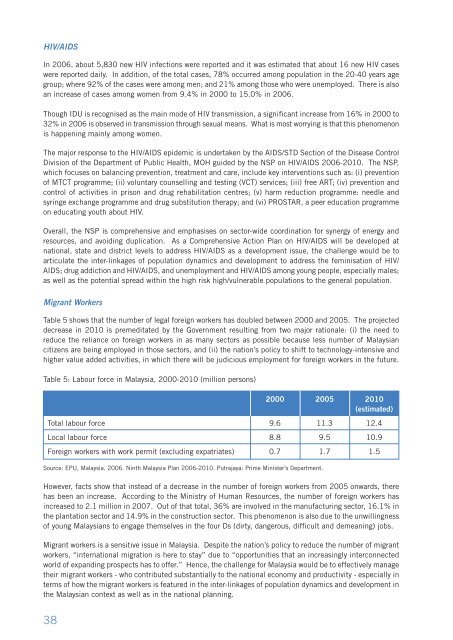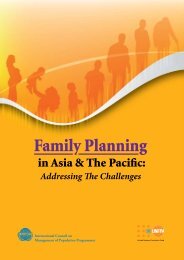Inter-lInkages between PoPulatIon DynamIcs anD DeveloPment In ...
Inter-lInkages between PoPulatIon DynamIcs anD DeveloPment In ...
Inter-lInkages between PoPulatIon DynamIcs anD DeveloPment In ...
Create successful ePaper yourself
Turn your PDF publications into a flip-book with our unique Google optimized e-Paper software.
HIV/AIDS<strong>In</strong> 2006, about 5,830 new HIV infections were reported and it was estimated that about 16 new HIV caseswere reported daily. <strong>In</strong> addition, of the total cases, 78% occurred among population in the 20-40 years agegroup; where 92% of the cases were among men; and 21% among those who were unemployed. There is alsoan increase of cases among women from 9.4% in 2000 to 15.0% in 2006.Though IDU is recognised as the main mode of HIV transmission, a significant increase from 16% in 2000 to32% in 2006 is observed in transmission through sexual means. What is most worrying is that this phenomenonis happening mainly among women.The major response to the HIV/AIDS epidemic is undertaken by the AIDS/STD Section of the Disease ControlDivision of the Department of Public Health, MOH guided by the NSP on HIV/AIDS 2006-2010. The NSP,which focuses on balancing prevention, treatment and care, include key interventions such as: (i) preventionof MTCT programme; (ii) voluntary counselling and testing (VCT) services; (iii) free ART; (iv) prevention andcontrol of activities in prison and drug rehabilitation centres; (v) harm reduction programme: needle andsyringe exchange programme and drug substitution therapy; and (vi) PROSTAR, a peer education programmeon educating youth about HIV.Overall, the NSP is comprehensive and emphasises on sector-wide coordination for synergy of energy andresources, and avoiding duplication. As a Comprehensive Action Plan on HIV/AIDS will be developed atnational, state and district levels to address HIV/AIDS as a development issue, the challenge would be toarticulate the inter-linkages of population dynamics and development to address the feminisation of HIV/AIDS; drug addiction and HIV/AIDS, and unemployment and HIV/AIDS among young people, especially males;as well as the potential spread within the high risk high/vulnerable populations to the general population.Migrant WorkersTable 5 shows that the number of legal foreign workers has doubled <strong>between</strong> 2000 and 2005. The projecteddecrease in 2010 is premeditated by the Government resulting from two major rationale: (i) the need toreduce the reliance on foreign workers in as many sectors as possible because less number of Malaysiancitizens are being employed in those sectors, and (ii) the nation’s policy to shift to technology-intensive andhigher value added activities, in which there will be judicious employment for foreign workers in the future.Table 5: Labour force in Malaysia, 2000-2010 (million persons)2000 2005 2010(estimated)Total labour force 9.6 11.3 12.4Local labour force 8.8 9.5 10.9Foreign workers with work permit (excluding expatriates) 0.7 1.7 1.5Source: EPU, Malaysia. 2006. Ninth Malaysia Plan 2006-2010. Putrajaya: Prime Minister’s Department.However, facts show that instead of a decrease in the number of foreign workers from 2005 onwards, therehas been an increase. According to the Ministry of Human Resources, the number of foreign workers hasincreased to 2.1 million in 2007. Out of that total, 36% are involved in the manufacturing sector, 16.1% inthe plantation sector and 14.9% in the construction sector. This phenomenon is also due to the unwillingnessof young Malaysians to engage themselves in the four Ds (dirty, dangerous, difficult and demeaning) jobs.Migrant workers is a sensitive issue in Malaysia. Despite the nation’s policy to reduce the number of migrantworkers, “international migration is here to stay” due to “opportunities that an increasingly interconnectedworld of expanding prospects has to offer.” Hence, the challenge for Malaysia would be to effectively managetheir migrant workers - who contributed substantially to the national economy and productivity - especially interms of how the migrant workers is featured in the inter-linkages of population dynamics and development inthe Malaysian context as well as in the national planning.38














